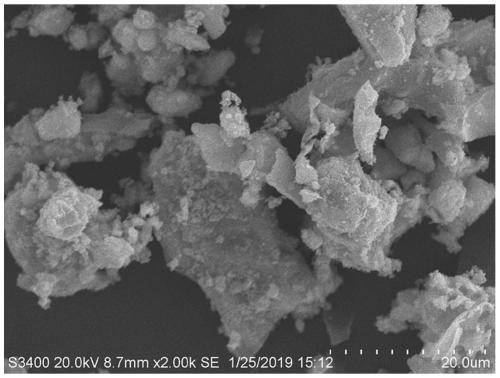Magnetic biomass carbon-quaternary phosphonium salt sterilization material, and preparation method and using method thereof
A magnetic biomass charcoal, biomass charcoal technology, applied in the fields of botanical equipment and methods, chemicals for biological control, chemical instruments and methods, etc. Recycling and other issues, to achieve high-efficiency sterilization, good sterilization efficiency, and the effect of overcoming drug residues
- Summary
- Abstract
- Description
- Claims
- Application Information
AI Technical Summary
Problems solved by technology
Method used
Image
Examples
Embodiment 1
[0050] This embodiment is the preparation process of magnetic biochar, including the following steps, first preparing magnetic biochar, specifically:
[0051] 1) Preparation of precursor biochar
[0052] First, refer to the method involved in the patent Chinese patent application number CN200920232191.9 to obtain corn stalk charcoal at 500°C, wash the corn stalks with tap water and deionized water in sequence, and then dry them in an electric blast drying oven at 80°C for 12 hours.
[0053] The dried corn stalks were transferred to the reactor of the straw charcoal plant, and the temperature was programmed to rise under low oxygen conditions, starting from 200°C, and each temperature node (300°C and 400°C) was kept for 1.5h until it reached 500°C. No more heat up. When no black smoke is discharged from the reaction furnace, the carbon making device can be closed, and after cooling to room temperature, the prepared biochar is ground and sieved.
[0054] 2) Preparation of magn...
Embodiment 2
[0060] This embodiment is the preparation process of magnetic biomass charcoal-quaternary phosphonium salt bactericidal material (mass ratio 1:1), the main steps are as follows:
[0061] 1) Take 1.0 g of the magnetic biochar prepared in Example 1, place it in a beaker containing 200 mL of deionized water, and add 1.0 g of tributyldodecylphosphine bromide at the same time, and stir the magnetic particles overnight at room temperature (12h);
[0062] 2) After the impregnation is sufficient, the temperature is raised to 65°C, and the hydrothermal reaction is carried out for 4 hours. After cooling to room temperature, the product was magnetically separated, washed several times until the pH of the sample washing solution was neutral, and placed in a vacuum drying oven (70°C, -0.06MPa) to finally obtain a magnetic biochar with a mass ratio of 1:1- Quaternary phosphonium salt bactericidal material.
[0063] Such as figure 2 , the resulting product has a saturation magnetization ...
Embodiment 3
[0065] Preparation of magnetic biochar-quaternary phosphonium salt bactericidal material (mass ratio 1:10)
[0066] Get 1.0g of the magnetic biochar prepared in Example 1, place it in a beaker containing 200mL of deionized water, and add 10.0g of tributyldodecylphosphine bromide simultaneously, and stir the magnetic particles overnight at room temperature (12h ), fully impregnated. The temperature was raised to 65°C, and the hydrothermal reaction was carried out for 4h. After cooling to room temperature, the product was magnetically separated, washed several times until the pH of the sample washing liquid was neutral, and placed in a vacuum drying oven (70°C, -0.06MPa), to finally obtain magnetic biochar with a mass ratio of 1:10- Quaternary phosphonium salt bactericidal material.
[0067] Such as figure 2 , the resulting product has a saturation magnetization of 53.29emu / g (curve 3) at room temperature; as image 3 , the XRD spectrogram presents corresponding magnetic ir...
PUM
 Login to View More
Login to View More Abstract
Description
Claims
Application Information
 Login to View More
Login to View More - R&D
- Intellectual Property
- Life Sciences
- Materials
- Tech Scout
- Unparalleled Data Quality
- Higher Quality Content
- 60% Fewer Hallucinations
Browse by: Latest US Patents, China's latest patents, Technical Efficacy Thesaurus, Application Domain, Technology Topic, Popular Technical Reports.
© 2025 PatSnap. All rights reserved.Legal|Privacy policy|Modern Slavery Act Transparency Statement|Sitemap|About US| Contact US: help@patsnap.com



